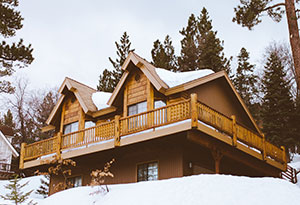Winter Ready with DIY EPS Insulation
 Right on the cusp of winter, November is a fitting time to get your home shipshape by insulating from top (attic) to bottom (basement) to door (garage). While a variety of home insulation products are at your disposal, consider opting for expanded polystyrene (EPS). Since it’s lightweight, it can be installed with ease. And unlike fiberglass insulation, EPS can be cut with common household tools like a razor knife or reciprocating saw and won’t litter your arms with fiberglass strands. What’s more, its impressive insulating performance helps to reduce your home’s energy consumption, which in turn slims down your monthly utility bill.
Right on the cusp of winter, November is a fitting time to get your home shipshape by insulating from top (attic) to bottom (basement) to door (garage). While a variety of home insulation products are at your disposal, consider opting for expanded polystyrene (EPS). Since it’s lightweight, it can be installed with ease. And unlike fiberglass insulation, EPS can be cut with common household tools like a razor knife or reciprocating saw and won’t litter your arms with fiberglass strands. What’s more, its impressive insulating performance helps to reduce your home’s energy consumption, which in turn slims down your monthly utility bill.
Ready to roll up your sleeves and properly insulate your home? Keep reading to see how you can easily tackle attic, basement and garage door insulation projects with EPS on your side.
When it comes to properly insulating your home, look up
To reduce your home’s energy consumption and lower your monthly utility bill, start with the attic. Because EPS boasts an inherently high R-value and is designed to resist moisture, it’s well-suited for an attics’ interior walls, roof and floor.
Installing these EPS insulation panels is a straightforward process: measure your attic’s knee wall and rafter height, then cut the panels accordingly using a table saw or straight edge and knife. Rather leave the slicing and dicing to someone else? Most home improvement stores offer a variety of pre-cut sizes, which makes it simple to find the best fit for your application. To complete installation, simply secure the panels into place with a cap nail or screw. For step by step instructions, check out our application video.
Insulate your basement to reduce energy consumption
Although often overlooked, adding extra insulation to a basement or crawl space can significantly reduce a home’s energy consumption. In fact, the U.S. Department of Energy (DOE) estimates that when a home is properly insulated, energy bills can be reduced by 20 percent. According to the EPS Industry Alliance, a well-insulated basement reduces heat flow from the hot exterior to the cool interior environment in the summer months, and, it reduces heat lost from the warm interior to the cold exterior in winter months.
Shore up your home’s largest energy drain, the garage door
One of the simplest ways to decrease your home’s energy consumption is to insulate the garage door, which is typically the largest uninsulated surface area of a house. To help shore up this energy drain and support an uncomplicated install, Insulfoam offers pre-configured garage door insulation kits that can be installed with common household tools. Get started by watching our Easy Weekend Project breakdown and step-by-step video.
For new homeowners and experienced DIYers alike, it can be intimidating to embark on home improvement projects as the weather cools and days shorten. However, projects that can reduce your home’s energy consumption are well worth the time, and EPS from Insulfoam makes tackling insulation projects easy.

